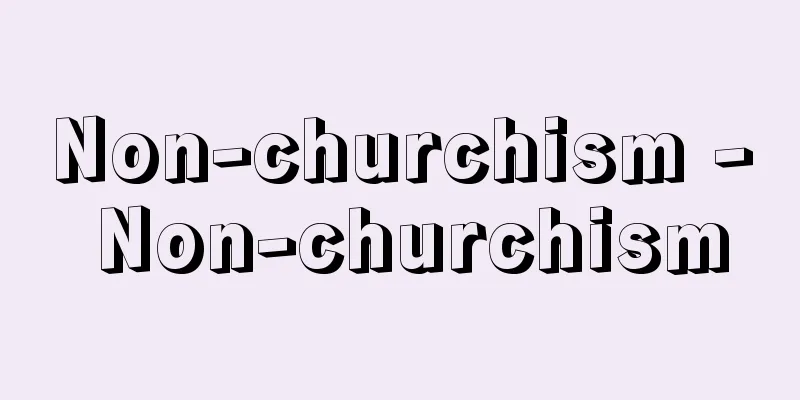Non-churchism - Non-churchism

|
The way of Christianity advocated by Kanzo Uchimura. While studying at Sapporo Agricultural College, Uchimura learned of the harmful effects of denominationalism by missionaries, and established an independent church in Sapporo. Later, influenced by the Christian Friends movement, his strong independent spirit, nationalism, and his relationship with the church led him to actively express his anti-churchism. The term "anti-church" was first used in "Chapter 3: When Abandoned by the Christian Church" in "Consolation for Christian Believers" published in 1893 (Meiji 26). In 1901 (Meiji 34), he founded the magazine "Anti-church," in which he described "Anti-church" as "the church of those without a church" (Issue 1). The term "anti-churchism" was also used for the first time in Issue 3 of the magazine. According to Uchimura, church buildings, teacher qualifications, and rituals such as baptism and the Eucharist are not essential to Christianity. However, rather than completely rejecting churches and their rituals and institutions, he later wrote that "non-church churches should proactively become churches." Uchimura perpetuated his non-church Christianity through Bible lectures and the publication of evangelistic magazines, and even after his death, many meetings continue to be held in roughly the same way all over Japan, even if there are some differences in theological interpretations of non-church churches. [Norihisa Suzuki] Source: Shogakukan Encyclopedia Nipponica About Encyclopedia Nipponica Information | Legend |
|
内村鑑三(うちむらかんぞう)の主張したキリスト教のあり方。内村は、札幌農学校在学中から、宣教師による教派主義の弊害を知り、札幌に独立の教会を設立した。その後、フレンド派のキリスト教の影響、強い独立精神、ナショナリズム、教会との関係などから、積極的に無教会主義を表明することになる。「無教会」ということばは、1893年(明治26)に刊行された『基督(キリスト)信徒の慰(なぐさめ)』の「第3章 基督教会に捨てられし時」にみいだされ、1901年(明治34)には雑誌『無教会』を創刊して、そこで「無教会」を「教会の無い者の教会」(第1号)と述べている。また同誌の第3号において「無教会主義」の語も初めて用いられている。内村によれば、教会の建物はもちろん、教師の資格も洗礼や聖餐(せいさん)などの儀礼も、キリスト教に不可欠のものでない。しかし、教会やその儀式・制度をすべて否定するのではなく、のちには「無教会は進んで有教会となるべきである」とも記している。内村は、聖書講義と伝道誌の発行を中心として、その無教会主義のキリスト教を存続させたが、その没後も、無教会主義をめぐる神学的解釈には若干相違があったとしても、ほぼ同じような方法で多くの集会が日本各地で続けられている。 [鈴木範久] 出典 小学館 日本大百科全書(ニッポニカ)日本大百科全書(ニッポニカ)について 情報 | 凡例 |
>>: Oil-free bearing - oilless bearing
Recommend
Kayapo - Kayapo
...the name given to the tribes who speak the lan...
Reliques of Ancient English Poetry
...That is to say, the term originally meant &quo...
Eutectoid transformation point
…(1) Isothermal transformation curve Also called ...
Chuo-geng-lu (English: Record of cultivation)
An essay from the late Yuan Dynasty in China. The ...
Trisetum sibiricum
…[Tetsuo Koyama]. … *Some of the terminology that...
evergreen candytuft
...Iberis umbellata L. (English name: purple cand...
Tristellateia australasica R.Rich.
An evergreen climbing woody plant of the Atractyla...
Kanzanchiku - Kanzanchiku
A bamboo or bamboo species of the grass family (A...
Reproduction
The process by which organisms produce new indivi...
Abangan (English spelling)
A Javanese word referring to a Muslim who is not v...
Government short-term securities
Based on the Public Finance Act or each Special A...
Continuous miner
...In the latest hovels, the hovel body, which is...
Sea of Okhotsk air mass
A cold, humid air mass that appears in the Sea of...
Kamikawa Basin
A large basin in the center of Hokkaido. It is bo...
glottis
...The Adam's apple, which is the entrance to...




![Alaska Pulp [Company] - Alaska Pulp](/upload/images/67cf413b22acc.webp)




